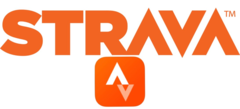Strava
| Strava
|
|
|---|---|

|
|
| Basic data
|
|
| developer | Strava Inc. |
| Publishing year | 2009 |
| Current version |
99.0.0 ( May 22, 2019 ) |
| operating system |
Android , iOS and via browser |
| category | endurance |
| License | proprietary |
| German speaking | Yes |
| www.strava.com | |
Strava is a social network for internet-based tracking of sporting activities such as cycling , jogging , swimming , skiing or rowing . It is operated by the company of the same name based in San Francisco . In 2017, 136 million runs were uploaded, which together resulted in a distance of over 1.1 billion kilometers.
properties
Strava members can use a mobile application for smartphones or a compatible GPS receiver to save distances covered, including information on duration, gradient, speed, effort, temperature or energy expenditure. You can then evaluate the data in more detail and compare your own performance with other members of the network. Some of the services offered are free, but functionality can be expanded for a fee.
In contrast to other networks of this type, Strava also use professional athletes such as racing cyclists André Greipel , Mark Cavendish , Michał Kwiatkowski and Marianne Vos . In this way, current data from various professional bike races can be evaluated on a regular basis.
Furthermore, Strava has a segment analysis with leaderboards for paying members. Therefore every user can generate a segment from a recorded route. If you then cycle or run over this segment and upload the file to Strava, you will be included in the best times list for this segment; an additional motivation that few training platforms offer. The recorded data can be exchanged with other applications and Internet applications and with other sports tracking applications via the GPS exchange format (GPX). In May 2020, Strava announced that it would only provide segment evaluation with leaderboards for paid members and that it would combine the previous paid packages from the Summit brand in a membership model.
Strava is available in German, English, French, Italian, Japanese, Korean, Chinese (traditional), Dutch, Portuguese (Brazil and Portugal), Russian and Spanish (Spain and Latin America). In addition, there are numerous extensions offered by private users or other companies that significantly expand the scope of Strava, both free of charge and for a fee.
Public data usage
Strava offers the data collected via the network to traffic planners who can use it to determine the real use of streets and paths by pedestrians and cyclists, as well as, if necessary, water sports enthusiasts. Usually only selective data is available about these road users. In the so-called heat map , the routes of the users worldwide are aggregated and represented by color values depending on the density. This means that the intensity of use of traffic routes can be determined. Individual evaluations can be obtained from public institutions and other users via a specially developed research program.
The use of Strava by members of the US military and the voluntary entry of movement data in the aforementioned heat map resulted in a security risk for emergency services stationed in Syria and Iraq . Using jogging routes that are open to the public, it is possible to locate locations and sometimes the ground plans of various military bases, especially in sparsely populated regions.
Web links
- www.strava.com Official website of the Strava network
- www.scarletfire.co.uk/strava-sites Currently available applications for expanding Strava
Individual evidence
- ^ Strava: Run, Ride, Swim . (accessed on May 27, 2019).
- ↑ Strava: 2017 in numbers
- ↑ Drew Robb: The Global Heatmap, Now 6x Hotter , strava engineering on Medium.com, November 1, 2017
- ^ Strava: Heatmap
- ↑ Strava: metro.strava
- ↑ Strava fitness app reveals secret military bases. January 29, 2018, accessed January 31, 2018 .
- ↑ Eike Kühl: "The enemy in my sneaker" Zeit.de of January 29, 2018
- ↑ Benedikt Fuest: "This fitness app reveals secret military bases" Welt.de of January 29, 2018